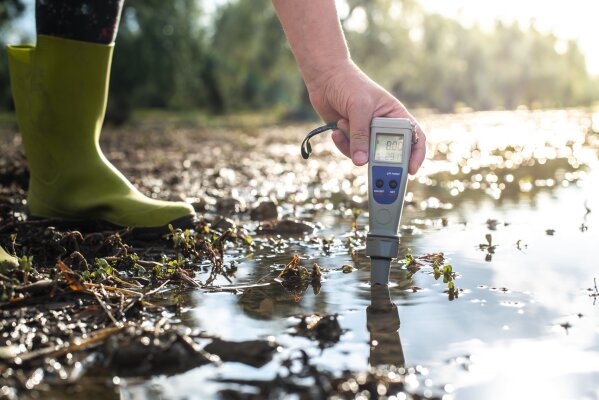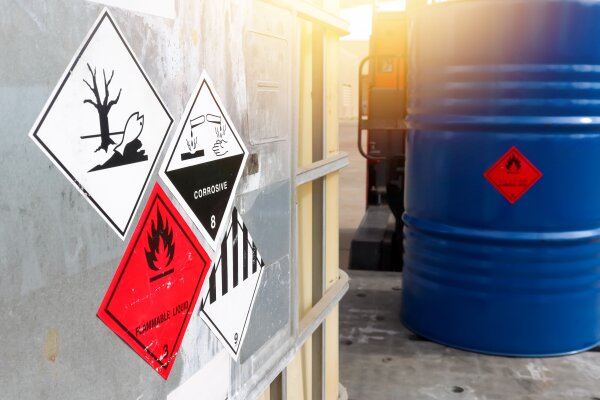pH meter: Functionality simply explained

So-called pH meters are used to determine the pH value of a solution electrochemically. In contrast to the acid-base indication, a much more precise value can be determined in this way. In this blog post, we have compiled a compact summary of what pH meters are, how they are constructed, and what needs to be taken into account with regard to their use and how they work.
What is a pH meter?
When we talk about a pH meter, we are talking about a device for the electrochemical determination of the pH value of a solution. It measures a voltage that changes according to the pH value. Typically, these gauges are equipped with an analog or digital display and can be found in many fields. These are used in laboratories of all kinds: from environmental engineering to quality control of products and foodstuffs.
Among the many advantages over other determination methods (think, for example, of titration) is the high measurement and display accuracy. Depending on the model and manufacturer, it can be as low as 0.01 pH, which ensures particularly accurate readings. By the way, pH meters are not always the same – so different types can be differentiated from each other, based on different measurement principles:
- ISFET: Some pH meters now work with a measuring principle based on an ISFET (ion sensitive field effect transistor). Downstream electronics are used, which reduces the service life of the sensor and ensures more stable measured values.
- Glass membrane: Classical pH meters are those with a glass membrane. This is also called an electrode and forms an electrical potential through a half-cell reaction. Thus, a direct dependence of the H+ ion concentration can be derived, which determines the pH value.
- Digital pH meter: A distinction can also be made between digital and manual pH meters. Digital models come in many sizes, designs and price ranges and can be operated at the touch of a button. This sometimes makes the measurement much easier.
- Manual pH meter: This is contrasted by manual variants, which are usually somewhat less expensive to purchase. They usually have an adjustment screw (instead of a knob) that must be loosened. At the end is a pen that is dipped into the solution.
pH meter: Structure and function
Although not all meters are alike, there are some basic similarities in pH meter design and function. This includes, for example, using an electrical potential for measurement. To create this, some important components must not be missing. Most often, for the optimal operation of the pH meter …
- a membrane glass resistor,
- a contact point,
- matching membranes,
- Diaphragmen
- as well as reference electrolytes are required.
Membrane glass resistance
The membrane glass resistance isthe internal electrical resistance of the glass electrode, which determines the characteristics of the electrode. Other terms may also be common, sometimes depending on the manufacturer. However, this is not a static quantity, but a value that is strongly dependent on the conditions of use and storage. Not least because of this, it changes over time.
Therefore, in order to maintain the pH meter functioning, it is elementary to maintain this useful part and to perform a regular calibration. Only then can the total resistance for determining the pH value be optimally measured by the membrane glass resistance.
Contact point/transfer
The contact point, also known as the transfer point, serves as the point of contact between the two solutions – usually this means the measuring solution and reference electrolyte solution inside the pH meter. The nature of this contact point again depends on the model, but diaphragms, capillaries or gaps in particular can be found at this point.
It is important that the resistancebetween the two solutions at this point is as low as possible. Contamination, for example, contributes to the signal becoming too unstable due to a high resistance and a measurement can no longer be carried out.
Membranes
The membranes inside the pH meter are manufactured in various forms and should each be adapted to its own area of application. They are mostly made of glass and form the pH-sensitive part of the electrode. Especially these forms occur frequently:
- Spherical diaphragm: This is found in most meters and is used for measuring liquids. The special shape allows the electrical resistance to be kept as low as possible.
- Cylinder diaphragm: The cylinder shape is also used for liquids and is particularly suitable for an application that places demands on the robust mechanics of the pH meter.
- Cone diaphragm: For pastes, on the other hand, cone-shaped diaphragms are ideal, as they are equally robust, pressure-resistant and undemanding to clean.
- Needle diaphragm: Finally, there are needle diaphragms, which are again used for semi-solid media. Due to the pointed shape, they can be used quite easily for piercing measurements.
Diaphragms
So-called diaphragms are responsible for the electrical connection between the test sample and the reference solution. Alternatively, some gauges have a slit or capillaries. Depending on the field of application, different designs can be mentioned again:
| Diaphragm type | Application area |
| Slit diaphragm | Weakly buffered and low electrolyte solutions |
| Open diaphragm | Gel or solid electrolyte or electrolytes with low leakage (such as dairy products and food). |
| Ceramic diaphragm | Aqueous and clear media (such as swimming pool water) |
| Plastic diaphragm | Heavily contaminated media (e.g. waste water) |
| Teflon ring diaphragm | Media containing oil and grease |
| Fabric diaphragm | Outdoor measurements (such as lakes) |
| Perforated diaphragm | Gel or solid electrolyte or electrolytes with low leakage (such as dairy products and food). |
| PTFE diaphragm | Solutions with dissolved solids (e.g. must and wine) |
Reference electrolyte
Another important component in the spectrum of pH meter functions is the reference electrolyte. This is required for comparison with the test sample and can be installed in different aggregate states. Although liquid electrolyte solutions are most common, some pH meters also work with gel or solid electrolytes:
- Liquid:Liquid electrolytes are usually based on KCL or KCL+Ag/AgCl and are refillable, for which the measuring instrument must be technically designed. This makes cleaning and maintenance particularly easy and user-friendly.
- Gel: Gel electrolytes, on the other hand, are more pressure resistant and less prone to fouling over time. Especially industrial application purposes as well as outdoor measurements are carried out with this variant.
- Solid: Finally, there are solid electrolytes, which consist of a conductive polymer. These cannot be replaced, but are best suited for applications under a high pressure influence. Therefore, they are often used in industrial areas.
| Note: Gel electrodes are simpler in construction and less expensive. They are particularly practical for single measurements. Gas electrodes need to be refilled, but are best suited for soft water. |
Measuring principle
In order to understand how the pH meter works, the measuring principle must be briefly explained. The basis is the electrochemical determination of a potential, which takes place at the glass electrode. With the help of a half-cell reaction, the electrical potential is formed there, which is directly dependent on the concentration of H+ ions.
According to the Nernst equation, it can be deduced that the ion concentration allows conclusions to be drawn about the pH value. Consequently, the measuring instrument can determine via the potential difference to the reference electrode which voltage is present – and which ion concentration is behind it. This voltage can be mapped linearly.
Both glass electrodes and field effect transistors have a corresponding reference electrolyte solution inside, so this measurement principle can be applied. However, ISFET models are considered more stable because they have downstream electronics.
pH meter: How digital and manual models work
When purchasing a pH meter, there are a variety of manufacturers and models to choose from. Another major distinguishing feature is the type of pH meter – here a differentiation can be made between digital and manual models. Although both are similar in terms of their design and operation, different procedures occur, especially when calibrating these pH meters:
- Digital models: With digital pH meters, calibration is triggered directly at the push of a button. The probe only needs to be cleaned and held in the respective reference solutions – the rest is done automatically.
- Manual models: Manual gauges make this process a little more involved. Instead of a push button, they have a screw that must be loosened manually before calibration. The pin at the lower end is then immersed in the buffer solution and must be tightened after the measurement has been completed.
Tips for the pH meter
In order for the handling of the pH meter to function optimally and the measured values to be absolutely reliable, attention should be paid to some precautions during maintenance, cleaning, preparation and use. The following tips and explanations on how the pH meter works can already help to eliminate unnecessary measuring errors before the measurement:
- Calibration: The meter should be calibrated not only before first use, but also at intervals of no more than one year. A two-point calibration is usually used for this purpose, consisting of buffer solutions with a pH of 7.0 and a pH of 4.0 or 10.0. Calibration can be used to ensure that the measurement results remain accurate.
- Cleaning: In addition, regular cleaning of the pH electrode Contamination increases the resistance, so that no or only an inaccurate pH value is output. A suitable standard solution should be used for cleaning, depending on the type of contamination.
- Storage: In addition, special attention must be paid to the storage of the pH electrode. Depending on the duration of storage (short-term, medium-term or long-term), different electrolyte liquids are used in turn. KCl solutions, for example, are very suitable.
The pH meter operation should be understood before use
Although these meters are manufactured in different designs, the actual pH meter operation is extremely similar in most cases. This should be understood before use to prevent unnecessary measurement errors and inaccurate results. It is best to find out about the actual setup so that nothing can go wrong during maintenance and calibration.
FAQ
The glass electrode represents a common variant of pH electrodes and is dipped directly into the measuring solution. An electrical potential is subsequently created at it, which depends on the hydrogen ion activity of the solution. According to the Nernst equation, the instrument can thus easily derive and display the pH value.
The glass electrode acts as a probe. This only needs to be held in the measuring solution and the measuring process started to obtain an automated result. The half-cell reaction at the probe forms the electric potential.
The pH electrode is used to determine the electrochemical potential between the measuring cell and the reference half cell. This half-cell reaction is based on the basis that there is a direct dependence on H+ ion concentration. Conversely, the exact pH value can be output by the instrument using the reference electrode.
The pH electrode consists of several components. In addition to a membrane glass resistor and a contact point or transfer, this also includes (several) membranes and diaphragms. A reference electrolyte is also included, which assumes the function of a reference solution during the measurement.
Do you have questions about the topic or would you like to suggest a topic? Please contact us by phone at +49 30 2096579 00 or send us an email at info@medsolut.com.




